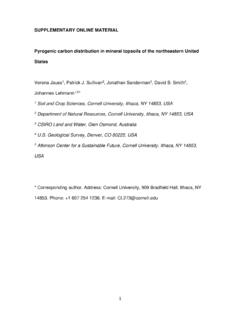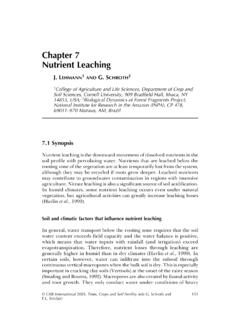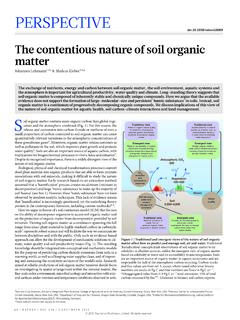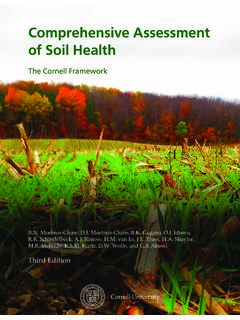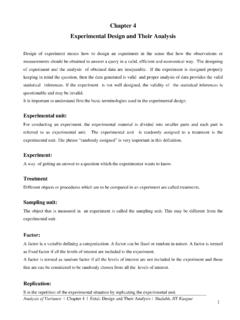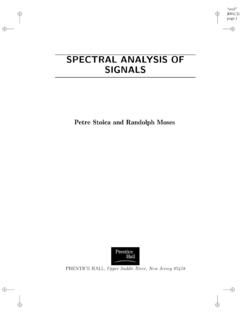Transcription of An example of statistical data analysis using the R ...
1 Tutorial:An example of statistical data analysisusing the R environment for statistical computingD G RossiterVersion ; May 6, 2017llllllll1020304050607080102030405060 7080 Topsoil clay %Subsoil clay %Subsoil vs. topsoil clay, by zonel1234 Slopes:zone 1 : 2 : 3 : 4 : : 15 10 5051015 Regression Residuals vs. Fitted Values, subsoil clay %FittedResidual1781119128137138139145660 0006700006800006900007000003150003200003 25000330000335000340000 GLS 2nd order trend surface, subsoil clay %ENCopyright D G Rossiter 2008 2010, 2014, 2017 All rights reserved.
2 Repro-duction and dissemination of the work as a whole (not parts) freely permitted ifthis original copyright notice is included. Sale or placement on a web site wherepayment must be made to access this document is strictly prohibited. To adaptor translate please contact the author Introduction12 example Data Loading the dataset .. A normalized database structure* ..53 Research questions84 Univariarte Univariarte Exploratory Data analysis .. Point estimation; inference of the mean .. Answers ..155 Bivariate correlation and Conceptual issues in correlation and regression.
3 Bivariate Exploratory Data analysis .. Bivariate Correlation analysis .. Fitting a regression line .. Bivariate Linear Regression .. Bivariate Regression analysis from scratch* .. Regression diagnostics .. to observed data .. residuals .. of residuals .. * .. * .. Prediction .. Robust regression* .. Structural analysis * .. Structural analysis by Principal Components* .. A more difficult case .. Non-parametric correlation .. Answers ..536 One-way analysis of variance (ANOVA) Exploratory Data analysis .
4 One-way ANOVA .. ANOVA as a linear model* .. Means separation* .. One-way ANOVA from scratch* .. Answers ..667 Multivariate correlation and Multiple Correlation analysis .. simple correlations .. partial correlations .. Multiple Regression analysis .. Comparing regression models .. regression models with the adjustedR2.. regression models with the AIC .. regression models with ANOVA .. Stepwise multiple regression* .. Combining discrete and continuous predictors .. Diagnosing multi-colinearity.
5 Visualising parallel regression* .. Interactions* .. analysis of covariance* .. Design matrices for combined models* .. Answers ..968 Factor Principal components analysis .. synthetic variables* .. * .. * .. * .. Factor analysis * .. Answers .. 1179 Postplots .. Trend surfaces .. Higher-order trend surfaces .. Local spatial dependence and Ordinary Kriging .. objects .. of local spatial structure .. by Ordinary Kriging .. Answers .. 13810 Going further140 References141 Index of R concepts146A Derivation of the hat Influence of values on prediction.
6 147ii1 IntroductionThis tutorial presents a data analysis sequence which may be applied to en-vironmental datasets, using a small but typical data set of multivariate pointobservations. It is aimed at students in geo-information application fields whohave some experience with basic statistics, but not necessarily with statisticalcomputing. Five aspects are emphasised:1. Placing statistical analysis in the framework of research questions;2. Moving from simple to complex methods: first exploration, then selectionof promising modelling approaches;3.
7 Visualising as well as computing;4. Making correct inferences;5. statistical computation and analysis is carried out in the R environment for statistical computing andvisualisation [16], which is an open-source dialect of the S statistical computinglanguage. It is free, runs on most computing platforms, and contains contribu-tions from top computational statisticians. If you are unfamiliar with R, see themonograph Introduction to the R Project for statistical Computing for use atITC [30], the R Project s introduction to R [28], or one of the many tutorialsavailable via the R web help is available for all R methods using the?
8 Methodsyntax at thecommand prompt; for example ?lmopens a window with help for thelm(fitlinear models) :These notes use R rather than one of the many commercial statisticsprograms because R is a completestatistical computing environment, based ona modern computing language (accessible to the user), and with packages con-tributed by leading computational statisticians. R allows unlimited flexibility andsophistication. Press the button and fill in the box is certainly faster but aswith Windows word processors, what you see isallyou get.
9 With R it may bea bit harder at first to do simple things, but you are not limited. R is completelyfree, can be freely-distributed, runs on all desktop computing platforms, is regu-larly updated, is well-documented both by the developers and users, is the subjectof several good statistical computing texts, and has an active user introductory textbook with similar intent to these notes, but with a wider setof examples, is by Dalgaard [7]. A more advanced text, with many interestingapplications, is by Venables and Ripley [35]. Fox [12] is an extensive explanationof regression modelling.
10 The companion Fox and Weisberg [14] shows how to useR for this, mostly with social sciences tutorial follows a data analysis problem typical of earth sciences, natural andwater resources, and agriculture, proceeding from visualisation and explorationthrough univariate point estimation, bivariate correlation and regression analysis ,multivariate factor analysis , analysis of variance , and finally some each section, there are sometasks, for which a possible solution is shown assomeR codeto be typed at the console (or cut-and-pasted from the PDF versionof this document.)


